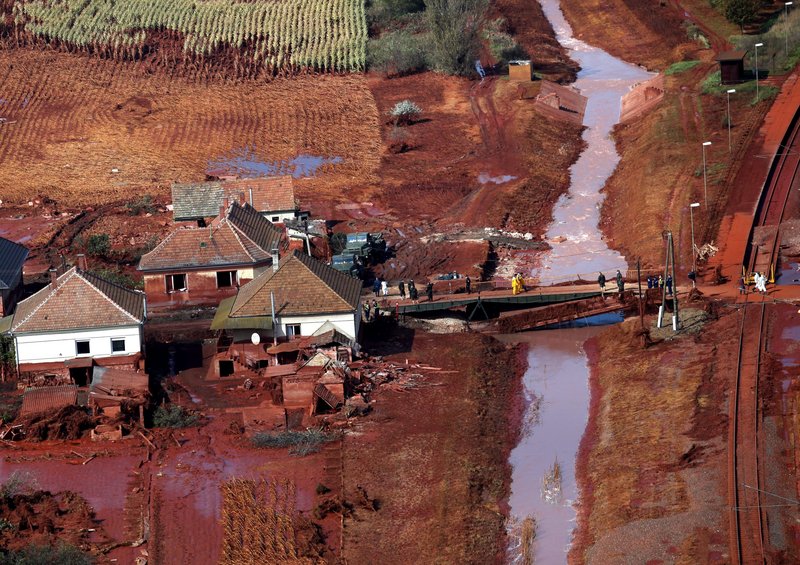KOLONTAR, Hungary – The concentration of toxic heavy metals where Hungary’s massive red sludge spill entered the Danube has dropped to the level allowed in drinking water, authorities said Friday, easing fears that Europe’s second longest river would be significantly polluted.
Monday’s reservoir break at an alumina plant dumped up to 184 million gallons of sludge onto three villages, government officials said, not much less in a few hours than the 200 million gallons the blown-out BP oil well gushed into the Gulf of Mexico over several months.
The red sludge devastated creeks and rivers near the spill site and entered the Danube on Thursday, moving downstream toward Croatia, Serbia and Romania. Monitors were taking samples every few hours Friday to measure damage from the spill but the sheer volume of water in the Danube appeared to be blunting the red sludge’s immediate impact.
Test results released by Hungary’s disaster agency show the pH level of the water where the slurry entered the Danube was under 9 — well below the 13.5 measured earlier in local waterways near the site of the catastrophe. That is diluted enough to prevent any biological damage, Interior Minister Sandor Pinter said.
Despite the apparent good news, the risk of pervasive and lasting environmental damage remained at the site of the spill, with Greenpeace presenting laboratory tests that it said showed high concentrations of heavy metals in the sludge.
Also Friday, the disaster’s confirmed death toll rose from four to seven. An 81-year-old man died from injuries sustained in the torrent and two bodies were found on the outskirts of Devecser. The unidentified victims were likely two of three Kolontar residents still missing, rescue agency spokesman Tibor Dobson said. The location of the bodies suggested they were swept over 2 miles by the torrent.
Elsewhere, officials in Croatia said analysis of the Danube’s water at Batina, where the river enters Croatia from Hungary, showed “no difference from its usual quality.”
Samples will be taken twice a day from today, said the Croatian Center for Prevention and Rescue. As a precaution, the town of Vukovar stopped using water from the Danube on Friday, relying instead on underground wells.
Hungarian Prime Minister Viktor Orban said the threat to the Danube had been eliminated, and the International Commission for the Protection of the Danube, a Vienna-based group that monitors the river and its tributaries, agreed.
“We managed to take control of the situation in time,” the state MTI news agency quoted Orban as saying.
In recent decades, the Danube has benefited from a massive cleanup effort involving all 10 countries that share the river. Marine life are again healthy, cormorants have returned to many stretches and the Danube delta emptying into the Black Sea is one of Europe’s greatest homes for unique wildlife.
At the site of the catastrophe, the environmental devastation was apparent. Red sludge samples taken Tuesday, a day after the spill, contained “surprisingly high” levels of arsenic and mercury, Greenpeace told reporters in Vienna on Friday. The analysis suggested that roughly 50 tons of arsenic, 300 tons of chrome and half a ton of mercury was unleashed by the spill, Greenpeace officials said.
They said the detected arsenic concentration was twice the amount normally found in so-called red mud, a waste product in aluminum production. Analysis of water in a canal near the spill also found arsenic levels 25 times the limit for drinking water, Greenpeace said.
With rain giving way to dry, warmer weather, the caustic mud was increasingly turning to airborne dust, which can cause respiratory problems, said Zoltan Illes, Hungary’s environmental chief.
Send questions/comments to the editors.



Success. Please wait for the page to reload. If the page does not reload within 5 seconds, please refresh the page.
Enter your email and password to access comments.
Hi, to comment on stories you must . This profile is in addition to your subscription and website login.
Already have a commenting profile? .
Invalid username/password.
Please check your email to confirm and complete your registration.
Only subscribers are eligible to post comments. Please subscribe or login first for digital access. Here’s why.
Use the form below to reset your password. When you've submitted your account email, we will send an email with a reset code.